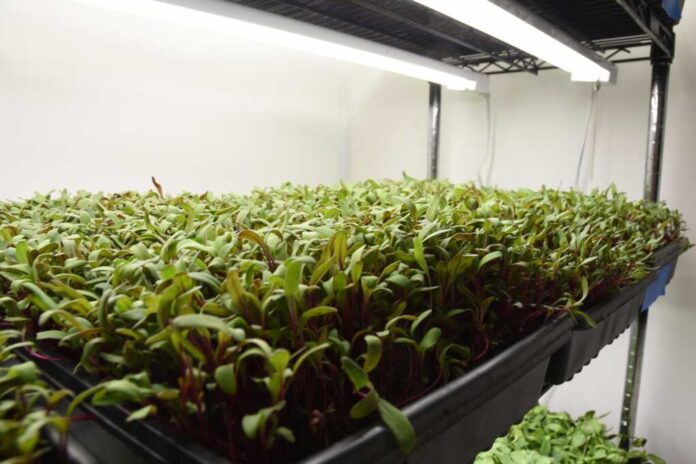
Welsh chef Gaz Oakley reveals three nutrient-packed foods anyone can grow indoors without a garden, bringing fresh ingredients to your kitchen regardless of space limitations.
At a Glance
- Microgreens, tomatoes, and lettuce are Oakley’s top recommendations for easy indoor growing
- Microgreens contain up to 40 times more nutrients than their fully-grown counterparts
- Indoor gardening offers benefits like higher production in small spaces and easier pest control
- Basic equipment needs include pots, organic seeds, potting soil, and adequate lighting
- Growing food indoors creates a deeper connection to nutrition and sustainable living
Why Indoor Gardening Makes Sense for Health-Conscious Adults
Indoor gardening has evolved from a casual hobby to an essential component of healthy living. For adults over 40 concerned about nutrition and wellness, growing food indoors offers remarkable control over what goes into your body. The practice eliminates exposure to commercial pesticides and provides ready access to nutrient-dense foods. Contrary to popular belief, you don’t need extensive outdoor space or gardening expertise to cultivate healthy foods. A sunny windowsill, a few pots, and some basic supplies are all that’s required to begin a transformative journey toward better nutrition and sustainable living.
Benefits extend beyond nutrition alone. Indoor gardening offers advantages such as higher production in limited spaces, easier pest management, protection from harsh weather, and elimination of weeding. For many, especially those living in apartments or with limited mobility, indoor gardening provides a practical solution for accessing fresh produce year-round. The activity also promotes mindfulness and serves as a fulfilling hobby that enhances overall well-being while delivering tangible rewards through harvest.
Microgreens: The Nutritional Powerhouse for Limited Spaces
Among Oakley’s three recommended indoor crops, microgreens stand out as the nutritional superstar. These young vegetable greens are harvested just after sprouting, typically when they’re 1-3 inches tall. What makes them remarkable is their concentrated nutritional profile – studies show they contain 4 to 40 times more nutrients than their fully-grown counterparts. This makes them an ideal choice for health-conscious individuals looking to maximize nutritional value from limited growing space.
Growing microgreens requires minimal equipment – shallow containers with drainage holes, organic potting soil, seeds (radish, broccoli, sunflower, pea, and cilantro are popular choices), and adequate light. They need only about 2 inches of soil depth and can be harvested with scissors in as little as 7-14 days after planting. This quick turnaround makes them ideal for maintaining continuous production. Oakley recommends incorporating freshly harvested microgreens into smoothies, as salad toppings, or as garnishes for soups and main dishes.
Tomatoes and Lettuce: Versatile Indoor Crops
Tomatoes represent Oakley’s second recommendation for indoor gardening. These versatile fruits are packed with vitamins A, C, and K, plus potassium and the antioxidant lycopene. Dwarf or determinate varieties like ‘Tiny Tim’ or ‘Window Box Roma’ are specifically bred for container growing and perform well indoors. While tomatoes require more space and light than microgreens, they reward growers with months of fresh produce. Place containers near south-facing windows or supplement with grow lights to ensure 6-8 hours of daily direct light.
Lettuce rounds out Oakley’s trio of recommended indoor crops. This leafy green thrives in cooler conditions and tolerates less light than many vegetables, making it perfect for homes with moderate indoor lighting. Loose-leaf varieties like ‘Black Seeded Simpson’ or ‘Red Sails’ perform exceptionally well in containers. Rich in vitamins K and A, folate, and antioxidants, lettuce can be harvested leaf by leaf (cut-and-come-again method) to extend production. For continual harvests, start new plants every 2-3 weeks. Lettuce grows quickly – you can begin harvesting outer leaves in as little as 3-4 weeks after planting.
Getting Started with Basic Equipment
The barrier to entry for indoor gardening is remarkably low. Essential equipment includes containers with drainage holes, organic potting soil, seeds or starter plants, and access to water and light. While natural light works well for many plants, supplemental lighting may be necessary during winter months or in homes with limited window exposure. LED grow lights have become increasingly affordable and energy-efficient. Temperature consideration is also important – most edible plants prefer temperatures between 65-75°F (18-24°C).
For beginners, starting with one type of plant before expanding is often the most successful approach. Microgreens offer immediate gratification with their quick growth cycle, while lettuce provides an easy transition to slightly more involved cultivation. Tomatoes require more attention to details like pollination (gently shaking flowering stems helps indoor plants pollinate) and support structures as they grow. Regular feeding with diluted organic fertilizer helps maintain plant health and productivity. The most important factor for success is consistency in care – regular watering, adequate light, and attentive monitoring for pests or disease.


















